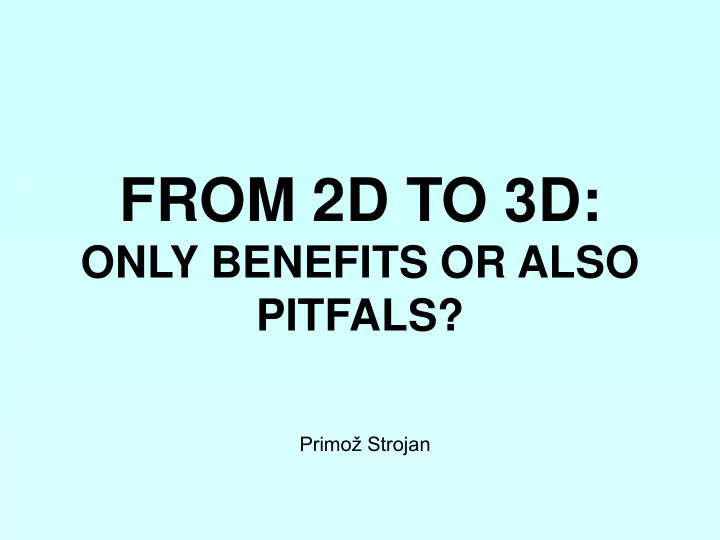

FROM 2D TO 3D: ONLY BENEFITS OR ALSO PITFALS? Primož Strojan
Conformity: High-dose volume is shaped to closely “conform” to the designed target volumes & Dose to critical normal tissues is minimal (as much as possible)
“2D” RT: Targets defined & dose calculated in 1. 2-dimensions Simple beam arrangements 2. Beams are not shaped or simple 3. beam-shaping devices are used - pre-manufactured blocks - individual shielding blocks Forward treatment planning 4. (trial-and-error process: field/beam weights are modified iteratively & manually)
2-D PLANNING
Computer based planning, calculation & visiualization distribution of dose
Missing tissue compensators Pre-manufactured (standard) blocks Custom-made alloy blocks
“Conformal” RT: Targets defined & dose calculated in 3- 1. dimensions Multiple beam directions 2. Beams are shaped (or intensity 3. modulated) Forward (or inverse*) treatment planning 4. *Computer-assisted optimization: definition of objectives and constrains determination of optimal beam arrangement & weighting
2-D PLANNING 3-D PLANNING
Anatomical data acquisitation
2D-RT 3D-RT IMRT 5 1 2 3 4
TARGET(S) NORMAL TISSUES more conformal dose as low dose as distribution possible TU NT CONFORMITY
TARGET(S) NORMAL TISSUES more conformal dose as low dose as distribution possible TU NT CONFORMITY STEEP DOSE GRADIENTS
“Conformal” RT: Targets defined / dose calculated in 3- 1. dimensions Multiple beam directions 2. Beams are shaped (or intensity 3. modulated) Forward (or inverse) treatment planning 4. PROBLEMS ?!
1. Increased risk of a marginal miss Tumor is not eradicated • Accurat identification of target(s) and OAR • Movements patient target beams
Identification of target and AORs
CT PET CT + PET
Movements ICRU Report 62, 1999
TARGET(S) NORMAL TISSUES more conformal as low dose as distribution possible TU TU NT NT CONFORMITY + STEEP DOSE GRADIENTS
Tumor reduction & weight loss Mayer JL. Karger: Basel, 2007. p.8.
2. Less homogenous dose distribution • Radiobiology – “double – trouble” effect late-responding tissues, large treatment volumes • Interpretation & verification of resulted dose distribution ICRU reference point, min, max, mean dose Dose distribution Dose Volume Histograms – DVHs to predict NTCP to assess quality of treatment plan
DVHs = 2D presentation of 3D dose distribution (what % of volume is raised to a defined dose)
DVHs • quantitative description of dose distribution - no information on spatia distribution - all regions of an organ are eaqually important - as good as is the anatomic information provided how accurately routine imaging reflect underlying anatomy marked inter-physician differences in image segmentation - interactions between organs are not considered - no information on functional status of nonirradiated organ volume
3. Larger total body dose Risk of radiation-induced malignancies • increased beam-on time ( MUs 2-3x) leakage through the collimator • more fields volume of NT exposed to lower RT doses 1% 1.75% for IMRT (Hall E & Wuu CS IJROBP 2003; Hall E. IJROBP, 2006)
4. Increase in costs More labour intensive and expensive
CONCLUSIONS “3D”: Targets defined in 3-dimensions using CT More complex beam arrangements and shaping More conformal dose distribution Steep dose gradients Identification of target(s) Patient immobilization and setup - risk of marginal miss - homogenous dose distribution - total body dose - in costs
Recommend
More recommend